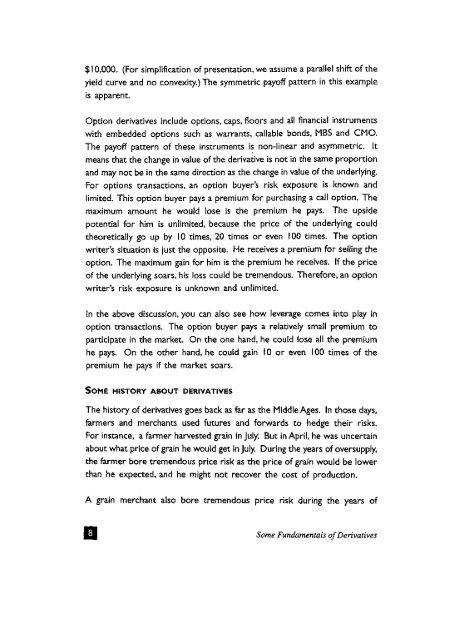Derivatives in Plain Words by Frederic Lau, with a ... - HKU Libraries
Derivatives in Plain Words by Frederic Lau, with a ... - HKU Libraries
Derivatives in Plain Words by Frederic Lau, with a ... - HKU Libraries
- No tags were found...
You also want an ePaper? Increase the reach of your titles
YUMPU automatically turns print PDFs into web optimized ePapers that Google loves.
$10,000. (For simplification of presentation, we assume a parallel shift of theyield curve and no convexity.) The symmetric payoff pattern <strong>in</strong> this exampleis apparent.Option derivatives <strong>in</strong>clude options, caps, floors and all f<strong>in</strong>ancial <strong>in</strong>struments<strong>with</strong> embedded options such as warrants, callable bonds, MBS and CMO.The payoff pattern of these <strong>in</strong>struments is non-l<strong>in</strong>ear and asymmetric. Itmeans that the change <strong>in</strong> value of the derivative is not <strong>in</strong> the same proportionand may not be <strong>in</strong> the same direction as the change <strong>in</strong> value of the underly<strong>in</strong>g.For options transactions, an option buyer's risk exposure is known andlimited. This option buyer pays a premium for purchas<strong>in</strong>g a call option. Themaximum amount he would lose is the premium he pays. The upsidepotential for him is unlimited, because the price of the underly<strong>in</strong>g couldtheoretically go up <strong>by</strong> 10 times, 20 times or even 100 times. The optionwriter's situation is just the opposite. He receives a premium for sell<strong>in</strong>g theoption. The maximum ga<strong>in</strong> for him is the premium he receives. If the priceof the underly<strong>in</strong>g soars, his loss could be tremendous. Therefore, an optionwriter's risk exposure is unknown and unlimited.In the above discussion, you can also see how leverage comes <strong>in</strong>to play <strong>in</strong>option transactions. The option buyer pays a relatively small premium toparticipate <strong>in</strong> the market. On the one hand, he could lose all the premiumhe pays. On the other hand, he could ga<strong>in</strong> 10 or even 100 times of thepremium he pays if the market soars.SOME HISTORY ABOUT DERIVATIVESThe history of derivatives goes back as far as the Middle Ages. In those days,farmers and merchants used futures and forwards to hedge their risks.For <strong>in</strong>stance, a farmer harvested gra<strong>in</strong> <strong>in</strong> July. But <strong>in</strong> April, he was uncerta<strong>in</strong>about what price of gra<strong>in</strong> he would get <strong>in</strong> July. Dur<strong>in</strong>g the years of oversupply,the farmer bore tremendous price risk as the price of gra<strong>in</strong> would be lowerthan he expected, and he might not recover the cost of production.A gra<strong>in</strong> merchant also bore tremendous price risk dur<strong>in</strong>g the years ofSome Fundamentals of <strong>Derivatives</strong>
















